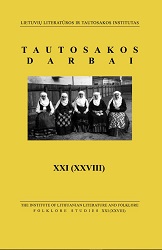PUBLIKUOTŲ TEKSTŲ PAVEIKTOS PASAKOS
FOLK TALES INFLUENCED BY THE PUBLISHED TEXTS
Author(s): Lina VALIUKAITĖSubject(s): Cultural history, Customs / Folklore, Comparative Study of Literature, German Literature, Lithuanian Literature, Theory of Literature
Published by: Lietuvių literatūros ir tautosakos institutas
Keywords: Folktales; folklore texts; Lithuanian folk tale; Aldona Liobytė; Grimm Brothers;
Summary/Abstract: The subject of the present investigation is an interaction between the published folk tales collections and the folklore texts, in the process of which folk tales told by the informants get published as part of the collections, afterwards repeatedly finding their way back into the oral tradition. The author of the article purports obtaining arguments to prove the impact made by the tale “The Frog Prince or the Iron Heinrich” from the collection of the Grimm Brothers and the literary tale by Aldona Liobytė Ramunė [“Marguerite”] upon several folklore texts. The compared annotations from the national indices of Lithuanian (AT 425C), Latvian, East Slavonic and Polish (AT 440) folk tales and the texts themselves present evidence of this particular tale having been well known in all the above mentioned national traditions, its variants being popular and alive, i.e. acquiring variations. The impact made by the published sources upon the folk narrative texts is studied according to the methodology for proving such an impact, introduced by J. A. Novikov. Thus, several variants of the Lithuanian folk tale, rather standing out in the general context, were discerned. These variants contain characteristic details of the literary tale by A. Liobytė, their female heroine is called Ramunė, and the personage of a bridegroom-frog apparently seems quite unusual for Lithuanian folk tales. These arguments present sufficient grounds to assert that several folklore texts recorded in Lithuania have been influenced by the literary tale Ramunė. Still, the direct impact of the tale from the Grimm Brothers collection onto the folk narrative variants appears much more difficult to prove, just like obtaining the reasoned proof of a link having existed between the literary tale Ramunė and the text from the Grimm Brothers collection. Yet it is also hard to imagine A. Liobytė borrowing the personage of the bridegroom-frog from the folklore tradition, as such variants are very few. Therefore an assumption of this strange personage in her literary tale having been created independently from the Grimm Brothers collection cannot be ultimately rejected.
Journal: Tautosakos darbai
- Issue Year: 2005
- Issue No: 29
- Page Range: 111-118
- Page Count: 8
- Language: Lithuanian

